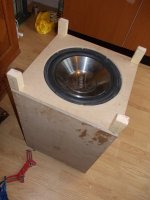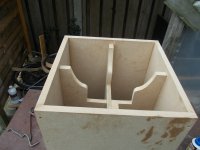With regard to determining the need to dampen structure borne vibration (cabinets), what about 'bumping' the cabinet panels and listening for ringing? The exciter can be a mallet. There is some technique to this as the softness of the mallet head and the firmness of the blow may need to be tailored to excite the panels at appropriate frequencies. As for listening, I would think a calibrated mic and something that dynamically displays the emitted frequency spectrum would be useful. Doing things like placing a hand on the panel or adding effective damping material should produce observable changes in the ringing.
Thoughts?
Thoughts?
I was wondering then, i have read the specs on a SS driver that recommends a 65 litre sealed enclosure so if you are going to stuff the box would you then use a box that is 15/20% less in volume so that you reach the recommended 65 litre volume once dampened? I hope that makes sense. So around 50 litre?Just to sum up, if you want to increase effective box volume, then filling with almost anything will add up to 20%, converting low frequency compression/expansion from adiabatic to isothermal (look those terms up).
To suppress internal acoustic energy at middle frequencies, use dense material on the internal walls and less dense towards the middle of the enclosure - and use something that actually works.
To reduce enclosure wall vibration, just make it very rigid (using bracing as necessary) and heavy. You can use constrained layer damping in larger boxes if they're thin-walled, but there'll still be significant output at low frequencies.
How could you measure this prior to building the enclosure is that possible Allen?Yes. Too much or too little material and it won't work as well, but this can be measured.
Numerous Simulators will show the effects of absorption
Of the many Q or Quality Factors in TS parameters
Qa = is for Absorption
Most simulators should include Qa
Felt lining or Poly fiber is used to reduce
reflections inside the box which can bounce
back to the speaker cone and cause frequency response peaks.
The Q measurements (Quality Factors) relate to the amount of relative damping in a loudspeaker.
They describe how well the driver can control its movement at the resonant frequency.
Q is the inverse of the damping ratio, and so lower Q values mean more control.
So a light lining of a vented box would have actual very
minimum effect of a speaker Q
Its mainly to reduce reflections
If a enclosure is overstuffed with absorption material
it then can have a effect on the damping or the driver.
Just like any other Quality factor
With a typical Vented box
Your just lining the cabinet to reduce reflections
and improve midrange response.
You would really have to heavily stuff a box
to start showing actual negative effects.
Of the many Q or Quality Factors in TS parameters
Qa = is for Absorption
Most simulators should include Qa
Felt lining or Poly fiber is used to reduce
reflections inside the box which can bounce
back to the speaker cone and cause frequency response peaks.
The Q measurements (Quality Factors) relate to the amount of relative damping in a loudspeaker.
They describe how well the driver can control its movement at the resonant frequency.
Q is the inverse of the damping ratio, and so lower Q values mean more control.
So a light lining of a vented box would have actual very
minimum effect of a speaker Q
Its mainly to reduce reflections
If a enclosure is overstuffed with absorption material
it then can have a effect on the damping or the driver.
Just like any other Quality factor
With a typical Vented box
Your just lining the cabinet to reduce reflections
and improve midrange response.
You would really have to heavily stuff a box
to start showing actual negative effects.
Last edited by a moderator:
Madisound wool stuffing.
https://www.madisoundspeakerstore.com/acoustic-damping/dampers-wool-stuffing/lb/
Seen a couple who used and liked.
Anyone here use it ?
https://www.madisoundspeakerstore.com/acoustic-damping/dampers-wool-stuffing/lb/
Seen a couple who used and liked.
Anyone here use it ?
Am I right in thinking this?
With a sub, the panel resonances would be above any frequency that the speaker will reproduce, so no damping required
Also, the path lengths inside the cabinet are shorter than any wavelength the speaker will produce, so no filling required
Brian
With a sub, the panel resonances would be above any frequency that the speaker will reproduce, so no damping required
Also, the path lengths inside the cabinet are shorter than any wavelength the speaker will produce, so no filling required
Brian
I have a sealed sub, so that is why I do ask about damping, this if for lowering qts also, I use a shelf filter for correcting until 20 hz. I have never try theFor a sub, i don't stuff them........
There are tests showing a lowering of qtc by stuffing (sealed sub)........
sub without damping, but have put more in past week as a result it looks now to have much less bass, I use the sub until 100Hz, but because the other two boxes can go to 50 hz low end I did thought about lowering that. I can try course what it does without damping. By the way the two Magnat speaker with bass reflex has also no damping whatsoever, I did also put a layer in, that did result in a lot more open and deeper sound.
I go take the measurement system out of the closed and go measuring the sub to see what happens.
For subs, the box dimensions will usually be much smaller than the wavelengths of interest - but don't forget harmonic distortion products, which may excite resonances higher than the crossover frequency.
Polyester is pretty useless as an absorptive stuffing material (fibreglass loft insulation is pretty much the best - but nasty), but will work as well as any alternative for gaining that extra ~20% of effective cabinet volume. Mainly for sealed boxes though, as bass reflex designs may not be particularly tolerant of excessive stuffing.
Polyester is pretty useless as an absorptive stuffing material (fibreglass loft insulation is pretty much the best - but nasty), but will work as well as any alternative for gaining that extra ~20% of effective cabinet volume. Mainly for sealed boxes though, as bass reflex designs may not be particularly tolerant of excessive stuffing.
What I cant follow is if a specific driver has a recommended specification of 55 litres for a sealed enclosure wont increasing the apparent volume by 20% be detrimental to the efficiency/performance of the driver? I thought you would have to reduce the actual volume of the cabinet by approx 20% if you go all out on the dampening.Rockwool is less nasty.
- Home
- Loudspeakers
- Multi-Way
- Speaker enclosure damping


![DSCN4751[1].JPG](/community/data/attachments/938/938859-f3394edb42d6f803804c64954dda6371.jpg)